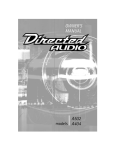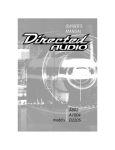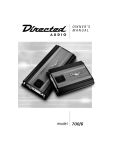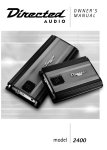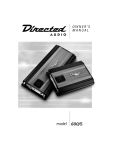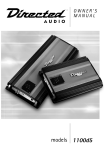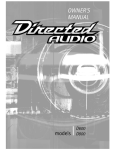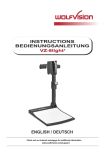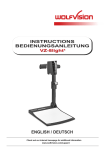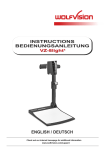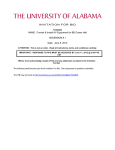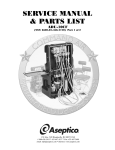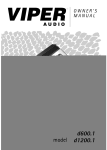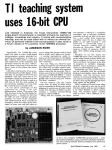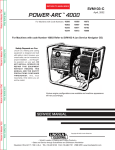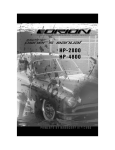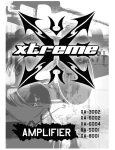Download Directed Audio D2400 User's Manual
Transcript
OWNER’S MANUAL models D1200 D2400 CONGRATULATIONS Congratulations for choosing a Directed Audio power amplifier from Directed Electronics, the industry leader in high quality automotive security and audio equipment since 1990. Directed Audio power amplifiers continue to set new standards of performance, reliability, and affordability in the mobile electronics industry. Featuring high-efficiency MOSFET power supplies, flexible on-board crossovers, and state of the art audio design, Directed Audio power amplifiers will excite and delight the mobile sound enthusiast with years of high-quality audio reproduction. Directed Audio power amplifiers come with a two-year limited warranty if installed by an authorized Directed dealer. If not installed by an authorized dealer, Directed Audio power amplifiers are covered by a one-year, parts-andlabor limited warranty. Be sure to retain your original sales receipt and refer to the warranty section of this guide for full details about your coverage. TABLE OF CONTENTS Limited Two-year Consumer Warranty . . . . . . . . . . . . . . . . . . . . . . . . . .3 Features . . . . . . . . . . . . . . . . . . . . . . . . . . . . . . . . . . . . . . . . . . . . .4 Warning . . . . . . . . . . . . . . . . . . . . . . . . . . . . . . . . . . . . . . . . . . . . . .4 Vehicle servicing note . . . . . . . . . . . . . . . . . . . . . . . . . . . . . . . . . . . . .5 Installation Guidelines . . . . . . . . . . . . . . . . . . . . . . . . . . . . . . . . . . . .5 Front Panel Connections/Controls . . . . . . . . . . . . . . . . . . . . . . . . . . . .7 Rear Panel Connections . . . . . . . . . . . . . . . . . . . . . . . . . . . . . . . . . . .9 ESP® Features and Controls . . . . . . . . . . . . . . . . . . . . . . . . . . . . . . .10 Speaker Wiring Diagrams . . . . . . . . . . . . . . . . . . . . . . . . . . . . . . . . .15 Combining Amplifiers . . . . . . . . . . . . . . . . . . . . . . . . . . . . . . . . . . . .16 Parallel Synced Gain Connections/Settings . . . . . . . . . . . . . . . . . . . . .17 External Synced Bridged Connections/Settings . . . . . . . . . . . . . . . . . . .19 Multiple Amplifier Combinations . . . . . . . . . . . . . . . . . . . . . . . . . . . . .21 Crossover Settings and Gain Adjustment . . . . . . . . . . . . . . . . . . . . . . .22 LED Tube Installation (Optional) . . . . . . . . . . . . . . . . . . . . . . . . . . . . .23 CEA Specifications . . . . . . . . . . . . . . . . . . . . . . . . . . . . . . . . . . . . . .24 Specifications . . . . . . . . . . . . . . . . . . . . . . . . . . . . . . . . . . . . . . . . .25 2 © 2005 Directed Electronics, Inc. all rights reserved LIMITED TWO-YEAR CONSUMER WARRANTY Directed Electronics, Inc. promises to the original purchaser, to replace this product should it prove to be defective in workmanship or material under normal use, for a period of two years from the date of purchase by the dealer as indicated by the date code marking of the product PROVIDED the product was installed by an authorized Directed dealer. During this two year period, there will be no charge for this replacement PROVIDED the unit is returned to Directed, shipping pre-paid. If the unit is installed by anyone other than an authorized Directed dealer, the warranty period will be one year from the date of purchase by the dealer as indicated by the date code marking of the product. During this one-year period there will be no charge for this replacement PROVIDED the unit is returned to Directed, shipping pre-paid. This warranty is non-transferable and does not apply to any unit that has been modified or used in a manner contrary to its intended purpose, and does not cover damage to the unit caused by installation or removal of the unit. This warranty is void if the product has been damaged by accident or unreasonable use, neglect, improper service or other causes not arising out of defects in materials or construction. ALL WARRANTIES INCLUDING BUT NOT LIMITED TO EXPRESS WARRANTY, IMPLIED WARRANTY, WARRANTY OF MERCHANTABILITY, FITNESS FOR PARTICULAR PURPOSE, AND © 2005 Directed Electronics, Inc. all rights reserved WARRANTY OF NON-INFRINGEMENT OF INTELLECTUAL PROPERTY ARE EXPRESSLY EXCLUDED TO THE MAXIMUM EXTENT ALLOWED BY LAW, AND DIRECTED NEITHER ASSUMES NOR AUTHORIZES ANY PERSON TO ASSUME FOR IT ANY LIABILITY IN CONNECTION WITH THE SALE OF THE PRODUCT. DIRECTED HAS ABSOLUTELY NO LIABILITY FOR ANY AND ALL ACTS OF THIRD PARTIES INCLUDING ITS AUTHORIZED DEALERS OR INSTALLERS. Unit must be returned to Directed, postage pre-paid, with: consumer’s name, telephone number, and address, authorized dealer’s name and address, and product description. IN ORDER FOR THIS WARRANTY TO BE VALID, YOUR UNIT MUST BE SHIPPED WITH PROOF OF INSTALLATION BY AN AUTHORIZED DIRECTED DEALER. ALL UNITS RECEIVED BY DIRECTED FOR WARRANTY REPAIR WITHOUT PROOF OF DIRECTED DEALER INSTALLATION WILL BE COVERED BY THE LIMITED ONE-YEAR PARTS AND LABOR WARRANTY. Note: This warranty does not cover labor costs for the removal and reinstallation of the unit. BY PURCHASING THIS PRODUCT, THE CONSUMER AGREES AND CONSENTS THAT ALL DISPUTES BETWEEN THE CONSUMER AND Directed SHALL BE RESOLVED IN ACCORDANCE WITH CALIFORNIA LAWS IN SAN DIEGO COUNTY, CALIFORNIA. 3 FEATURES Super-efficient Class D PWM design runs much cooler than conventional amps. High-speed MOSFET switching power supply. High-current complimentary Class D MOSFET outputs stable into one ohm loads. Thermal, DC offset, reverse polarity, and short circuit protection with status LED. Master/slave function supports two amps bridged to one load. Continuously variable 12dB/ octave low-pass crossover. Switchable subsonic filter, 24dB/octave . Switchable 8 dB bass EQ function. Switchable 180° phase inversion. Remote subwoofer level control function. Variable input sensitivity optimizes match with different signal sources. Chrome-plated wire terminals and RCA connectors ensure maximum signal transfer. Rugged 2-piece heatsink and cover. Unity gain pass-through RCA jacks. Programmable features controlled via ESP® serial databus and Directed's proprietary Bitwriter® tool (998T). The Bitwriter® unit must have version 2.0 or above to fully access the amplifier features menu. ESP® port for connection to ESP-2 Security components and currentBitwriter® module with programming. WARNING High-powered car audio systems may produce sound pressure levels that exceed the threshold at which hearing loss may result. 4 They may also impair a driver’s ability to hear traffic sounds or emergency vehicles. Use common sense and practice safe listening habits when listening to or adjusting your audio system. © 2005 Directed Electronics, Inc. all rights reserved VEHICLE SERVICING NOTE Prior to servicing your vehicle ensure that the alarm system is disarmed. Due to the amplifier’s anti-theft feature (if enabled), amplifier operation is disabled when the main power to the amplifier is removed while the alarm is armed. The amplifier operation must then be reset. If the alarm is replaced with another ESP2 alarm system, ensure that the amplifier goes through a learn routine (using the Bitwriter®) prior to reenabling the anti-theft feature. INSTALLATION GUIDELINES 1. Please read this owner’s manual carefully before installing this amplifier. 2. Disconnect the battery ground terminal prior to making any electrical connections. 3. Check for any hazards or obstructions such as gas tanks, fuel or brake lines, and wiring harnesses before mounting the amplifier. 4. Pick a mounting location that will provide adequate access and ventilation and protect the amplifier from heat, moisture, and dirt. 5. Avoid sharp metal areas when routing cables to the amplifier, and run RCA cables away from the power cables and other potentially noisy car harnesses. © 2005 Directed Electronics, Inc. all rights reserved 6. The amplifier should be grounded with a short, heavy gauge wire connected directly to the car at a bare metal surface, preferably scraped body sheet metal. Do not use factory ground locations, seat bolts, or brackets that are spot welded. 7. Always fuse your power connection within 8 to 10 inches of the battery terminal. Use a fuse or circuit breaker rated slightly more than the on-board fuse(s) of the amplifier(s). The gauge of power wire used should take into account the total current draw of the system, and the length of wire used. IASCA and other auto sound competition organizations have charts available for this; you can also find a chart in the MECP study 5 guide. Minimum wire gauge recommendations for the individual amplifiers are listed on the specification page. Always use the same gauge wire for the amplifier ground that you use for the power wire. Be sure to examine the battery ground cable of the vehicle, and if necessary, upgrade it by adding an additional ground wire that is the same gauge as the amplifier’s power wire. Remember, the amplifier can only deliver its rated output when it is not current limited by the power and ground supply wires. 8. This amplifier is designed to drive a speaker load that measures from 1 to 4 ohms. Keep in mind that heat is the long-term enemy of automotive electronics and the lower your speaker load, the more heat is generated. For low impedance speaker applications or restricted 6 ventilation installations, an external cooling fan may be advisable. 9. Battery and ground connections to the vehicle should be made with crimped ring terminals of the appropriate size (surface area is what counts); soldering the terminals after crimping is also recommended. 10. Due to the high-frequency MOSFET switching power supply, filtering the power cable is not generally required (remember that the amp can’t deliver full output if the power supply is restricted). Proper grounding of the signal source is mandatory for the amplifier to reach its performance peak. If the RCA inputs are not grounded adequately via the signal source, electrical noise from the vehicle may be picked up in the system. © 2005 Directed Electronics, Inc. all rights reserved FRONT PANEL CONNECTIONS/CONTROLS 1. RCA Input Jacks - Accepts line level outputs from head units or signal processors at voltages between 150mV and 7.5 volts. 2. RCA Line Output Jacks - These pass through RCA jacks can be used to send the input signal to a second amplifier. 3. Slave/Master Switch - Controls whether the amplifier is a slave or master when connected in combined amplifier configurations. (Refer to the Combined Amplifiers section of this guide.) 4. Gain Control - Controls the amplifier’s sensitivity and is used to match the input level of the amplifier to the output level of the signal source. 5. Subsonic Switch - The subsonic filter attenuates frequencies below 30Hz by 24dB per octave. 6. Bass EQ Switch - Adds 8dB of bass boost to the subwoofer when selected. 7. Remote - Controls the subwoofer amplifier gain, from a remote loca- © 2005 Directed Electronics, Inc. all rights reserved tion for ease of adjustment during listening. Warning: DO NOT connect a level control knob from other manufacturers to the Remote Sub Level Control of any Directed amplifier. Even though the connectors fit properly, the control knob and connector pin positions may be different and the amplifier will be damaged. 8. LPF Control - Controls low pass filter cutoff from 30Hz to 250Hz. 9. Phase Switch - 0° or 180° selectable for switching the phase output to the woofer. 10. LED/FAN Connector - Allows connection of an optional LED light bar or optional cooling fan for the amplifier. 11. Status LED - Will illuminate GREEN to indicate the amplifier is on and operating normally, and will be illuminated RED if the amplifier shuts down due to short circuit, DC offset, or overheating detected by onboard protection circuitry. 12. ESP ® Port - connection port for Bitwriter® or ESP2 security system. 13. ESP ® Status LED - indicates ESP® functionality and is used to diagnose ESP® features. 7 FIGURE 1—AMPLIFIER CONNECTIONS/CONTROLS D1200/D2400 FRONT 1 2 3 4 5 6 7 8 9 11 10 D1200/D2400 12 13 FIGURE 2—LED/FAN HARNESS BLACK BLUE BLACK RED 8 + + TO LEDs TO FAN © 2005 Directed Electronics, Inc. all rights reserved REAR PANEL CONNECTIONS 1. Fuses - These fuses protect the amplifier against internal electrical damage and are meant to protect the amplifier only. All other power connections should be fused at the source. The D1200 uses 2-30A fuses, and the D2400 uses 3-40A fuses. 2. (+) 12 Volt Power - Connect this terminal through a FUSE or CIRCUIT BREAKER to the positive terminal of the vehicle battery or the positive terminal of an isolated audio system battery. WARNING: Always protect this power wire by installing a fuse or circuit breaker of the appropriate size within 12 inches of the battery terminal connection. of the vehicle, using the shortest wire necessary to make this connection. Always use wire of the same gauge or larger than the (+) 12 volt power wire. The chassis connection point should be scraped free of paint and dirt. Use only quality crimped and/or soldered connectors at both ends of this wire. DO NOT connect this terminal directly to the vehicle battery ground terminal or any other factory ground points. 3. Speaker Terminals - Connect subwoofers to these terminals. (Refer to the Speaker Wiring Diagrams section of this guide.) 2. Remote Turn On - This terminal turns on the amplifier when (+) 12 volt is applied to it. Connect it to the remote turn on lead of the head unit or signal source. 2. Ground - Connect this terminal directly to the sheet metal chassis © 2005 Directed Electronics, Inc. all rights reserved 9 FIGURE 2—AMPLIFIER CONNECTIONS - REAR D1200 D2400 FUSE 40A x 3 ESP ® FEATURES AND CONTROLS These amplifiers incorporate an on-board Directed ESP® Engine. In addition to allowing menu-driven parameter adjustment*, operate with security products from Directed Electronics to incorporate advanced ESP2 features. Your dealer can use a Bitwriter® with Firmware version 2.0 or later to access these parameters. * Note: The ESP® features are obtained by using Bitwriter® and a 3 pin ESP® cable. While a Bitwriter® can only talk to one ESP®/ESP2 device at a time, multiple amplifiers can be set to respond to Arm/Disarm commands. 10 Simply repeat the TX ID Learn procedure for each amplifier. When completed use a Y-cable to connect the Alarm signals to both amplifiers. Note: Prior to using the anti-theft or valet features it is recommended that the alarm be installed and its functionality verified. Please consult the install or operations guide for the appropriate alarm. For the Bitwriter® to Amp connection, the cable must have the same color sequence at both ends of the cable. For the Alarm to Amplifier, the Transmit and Receive wires must cross from one end © 2005 Directed Electronics, Inc. all rights reserved to the other. Status indicator will not flash. Bitwriter® commands can control parameters such as Turn on Delay, Fan Control, Input Gain adjustment, and also place the amplifier into a monitoring state for commands from an ESP2 equipped alarm. - RESERVED - no function, reserved for future use. 1. Turn-On Delay - 0.75, 1.00, 1.25, 1.75, 2.25, 2.75, or 3.25 seconds. 1.75 seconds is the factory default setting. 2. Fan Control - AUTO - The fan will automatically turn on when the internal temperature exceeds approximately 40 deg C. The ON option causes the fan to operate whenever the Amplifier is on. Use the ON option if you are using the external FAN port to drive optional LED tubes. In the OFF mode the external FAN port is disabled. 3. Service Code Display - The Directed ESP® Engine stores up to seven previous faults for later replay. The Service Code Display allows the installer to step through the fault history. - OFF - In the OFF position, the amplifier operates normally. - FLASH CODE ON LED - the last recorded fault is "replayed" on the ESP® Indicator LED. If the unit has never recorded a fault, the ESP® © 2005 Directed Electronics, Inc. all rights reserved - CLEAR LAST FAULT - Clears the last fault. Note that this allows you to see previous faults prior by backstepping one at a time through the fault history. 4. Input Gain Range - The sensitivity on the gain control can be limited to specific ranges. The DEFAULT position allows adjustment over the full range of amplifier sensitivities. There are 4 other ranges 0.5-1.0V, 1.0V-2.0V, 2.0-4.0V, 4.0-8.0V. 5. Input Gain Adjustment - In the LOCK position, the gain range and gain control can be locked out to prevent accidental mis-adjustment. The Default mode is UNLOCKED. 6. Valet - Selecting ENABLE allows the amplifier to monitor valet signals from the alarm system. The amplifier will not power up once remote power is removed when the Valet monitoring mode is ENABLED and the alarm system has been set into Valet mode. Note: To make use of the Anti-theft or Valet features, the amplifier must "learn" which transmitters are associated with the currently used alarm system. See item 8 below. 11 If selected while the remote power is on, the amplifier will continue playing until the remote power is turned off. To Clear Valet Mode, Disable Valet mode on the alarm, then cycle the remote power line off then on again. The amplifier will power up normally after the Turn On Delay time has expired. 7. Anti-theft - Selecting ON, allows the amplifier to monitor Arm and Disarm signals from the alarm, rendering the amp in-operable if stolen. When OFF, these signals are ignored. OFF is the factory default setting. When main power is removed while the unit is armed, the unit is placed into a "stolen state". The ESP® Status indicator will blink rapidly, and the amplifier will not continue its power up sequence. Also when there is currently an ARM signal active on the bus, the amplifier cannot be written to by the Bitwriter®. To reactivate the amplifier, connect the alarm that was used to arm the amplifier, and press the disarm button. Ensure the remote line is off(turn it off if this is not the case), and then turn the amplifier on. The amplifier should power up 12 normally after the Turn On Delay expires. 8. Top Light Options i. Light On W/Service Code ii. Light Off W/O Service Code iii. Light On, W/O Service Code iv. Light Off, W/Service Code Default is Light On, W/O Service Code The amplifier contains the ability to control the lights on top of the unit behind the logo badge. In addition to custom tailoring many other features, your Directed Dealer can use a Bitwriter® (V2.0 or later) to setup the top light so that it is either on or off when the amplifier is on or off. In addition, the top light can indicate when the amplifier is in any of the fault shutdown modes, or can display the service code when this is being accessed. i. This option has the top light lit when the unit is on(remote line on), and indicates service codes and faults on the top light. ii. This option has the top light unlit when the unit is on, and doesn’t indicate service codes or faults on the top light. iii. This option has the top light lit, but does not indicate service codes or faults on the top light. iv. This option has the top light © 2005 Directed Electronics, Inc. all rights reserved unlit, but still indicates service codes or faults using the top light. 9. Learn TX IDs Default Off. Before the unit will respond to Arm/Disarm/Valet Commands from the alarm system, it needs to establish communications with this alarm system. This is established using the learn routine procedure described below. Once this procedure is performed, the unit will store this information permanently in memory. The procedure only needs to be repeated if the alarm unit is replaced or all the transmitters in an alarm system are replaced. 10. Major Version Number: This number will allow verification of the firmware installed in the amplifier. This will be useful information should your amplifier ever need service. 11. Minor Version Number: This number references the minor version of your amplifier firmware. To perform a transmitter "learn": 1. Connect Bitwriter® to amplifier. Press READ on the Bitwriter®. 2. Press the up arrow 3 times, or the down arrow 8Light On, W/O Service Code times to reach the Learn TX IDs menu. Press 'Select' © 2005 Directed Electronics, Inc. all rights reserved until the ON appears. 3. Press the write key twice. The ESP® status indicator should begin blinking. Note: The following should be accomplished within 20 seconds or the learn session will time out. If this occurs, the LED will stop blinking. Reconnect the Bitwriter® and press WRITE twice to re-enter the TX ID Learn mode. 4. Disconnect the Bitwriter® and connect the Amp to the alarm cable. 5. Press ARM on any transmitter attached to the alarm system. The LED should go on if the amplifier was on prior to TX ID or go out if the amplifier is off. Note: When the amplifier receives ESP® bus activity(typically either arm or disarm signals, it will blink to indicate Arm or Disarm commands. This allows the installer to verify that the proper cable is in use and that the transmitters have been properly programmed. The unit must still be programmed to respond to Valet and Arm commands with a Bitwriter® for the Anti-theft/Valet modes to lock out unauthorized operation. ESP ® Status Indicator: 13 The ESP® Status indicator flashes to indicate the current operational mode. This can be used in conjunc- Power/Protection LED tion with the Power LED to help determine the source of the problem. ESP® Status Indicator Mode Green Solid Red Normal Operation Green Flashing Turn On delay or TX learn Red Flashing Slowly Thermal shutdown Red Flashing Rapidly Overcurrent Red Slow Flash (50% duty cycle) Overvoltage Red Slow Flash (mostly off) Under-voltage Off Off Amplifier Off Off Flashing Arm/Valet received Off Flashing Rapidly Amplifier in Anti-theft/Valet On Flashing Amplifier armed Note: Remember that the Directed ESP® Engine incorporates a digital gain control with a finite number of adjustment steps (32). A very small adjustment may not cause any audible changes in output. In addition the range selected may further restrict the adjustment. Extremely quick, large changes may result in audible artifacts, particularly on low frequency material as the gain is changing more rapidly than the source electrical wave. 14 © 2005 Directed Electronics, Inc. all rights reserved SPEAKER WIRING DIAGRAMS Single subwoofer connection (top view) Two subwoofer connection (top view) NOTE: The dual + and -- sub-out terminals of the D600/D800/D1200/D2400 are paralleled internally and the combined load impedance should be taken into consideration when connecting multiple subwoofers. © 2005 Directed Electronics, Inc. all rights reserved 15 COMBINING AMPLIFIERS N OTE : Remember that the Directed ESP® amplifiers use a digital gain control with a finite number of adjustment steps. A very small adjustment may not cause any audible change in level. The Directed D1200/D2400 subwoofer amplifiers have the capability of connecting two or more amplifiers of the same power rating together in a master/slave combination for increased power with accurate level matching. They are the Parallel Synced Gain and External Synced Bridged combinations. WARNING: DO NOT attempt to combine amplifiers of different power ratings. These amplifier combinations work correctly only if the Master and Slave amplifiers are identical models. Parallel Synced Gain In this master/slave combination the master amplifier pre-amp controls remain active and the slave amplifier pre-amp is bypassed. This allows the master amplifier to control gain, filter, and sub-level on both amplifiers. This combination allows the amplifiers to drive their own separate subwoofer(s) while being synced together via an inphase audio pre-amp signal from the master amplifier. Wiring connections to the amplifier subwoofer outputs in this combination should be standard in-phase configurations, creating a parallel speaker connection. (Refer to Parallel Synced Gain section of this guide for amplifier and speaker connection 16 diagrams.) NOTE: One master amplifier can control up to three slave amplifiers in this combination. Multiple identical master/slave combinations can be added to any given system. External Synced Bridged In this master/slave combination the master amplifier pre-amp controls remain active and the slave amplifier pre-amp is bypassed. This allows the master amplifier to control gain, filter, and sub-level on both amplifiers. This combination allows the amplifiers to drive common subwoofer loads while being synced together via an out-of-phase audio pre-amp signal from the master amplifier. In this subwoofer wiring configuration the master amplifier sends the positive signal to the subwoofer while the slave amplifier sends the negative signal, making an externally bridged speaker connection. (Refer to External Synced Bridged section of this guide for amplifier and speaker connection diagrams.) NOTE: Amplifiers in this combination can only be connected in matched pairs. Multiple matched pairs may be added to drive separate subwoofer loads in a given system. Combined Amplifiers Gain and Filter Settings NOTE: You MUST set the Subsonic, EQ, and other filter settings on the master amplifier to the same positions to achieve safe, optimal results. Adjustment guidelines are discussed in the Crossover and Gain Adjustment section of this guide. © 2005 Directed Electronics, Inc. all rights reserved PARALLEL SYNCED GAIN CONNECTIONS/SETTINGS Refer to figure 5 for wiring details. 1. Input Signal - Connect these RCA jacks as described in the Front Panel Connection section of this guide. 2. Slave/Master Switch Set the slave/master switch on the master amplifier to the MASTER position. Set the slave/master switch on the slave amplifier to the SLAVE position. Setting the slave/master switch on both amplifiers will automatically set the I/O RCA jack configuration according to each amplifier’s slave or master designation. NOTE: One master amplifier can control up to three slave amplifiers in this combination. Multiple identical master/slave combinations can be added to any given system. 3. Phase Switch - Set the phase switches of all synced amps to the same position (all at 0° or all at 180°). © 2005 Directed Electronics, Inc. all rights reserved 4. In order to achieve safe, optimal performance, the LPF, Bass EQ, and Subsonic Filter controls on all synced amps must be set to the same position. 5. Signal Connection - Connect an RCA cable between the OUT RCA jack of the master amplifier and the SLAVE IN RCA jack of the slave amplifier as shown in the Figure 5. 6. Subwoofer Speaker Connection - In this amplifier combination each amplifiers must drive its own separate subwoofer(s). Connect the speaker terminals of each amplifier to any combination of one or more subwoofers that results in nominal impedance between one and four ohms. Make sure that each amplifier sees the same speaker impedance. WARNING: The amplifier’s gain control is bypassed completely in SLAVE mode. Do NOT move the MASTER/SLAVE switch to SLAVE position when the amplifier is connected and playing. Do NOT connect any signal source to the amplifier in SLAVE mode that exceeds 200mV. 17 FIGURE 5—PARALLEL SYNC GAINED D1200/D2400 MASTER AMPLIFIER INPUT LINE OUT PHASE MASTER SLAVE 0° MASTER SLAVE 0° 180° R L INPUT LINE OUT PHASE 180° R L SLAVE AMPLIFIER Subwoofer Wiring (top view) MASTER SLAVE NOTE: 18 The dual + and -- sub-out terminals are paralleled internally and the combined load impedance should be taken into consideration when connecting multiple subwoofers. © 2005 Directed Electronics, Inc. all rights reserved EXTERNAL SYNCED BRIDGED CONNECTIONS/SETTINGS 1. Input Signal - Connect these RCA jacks as described in the Front Panel Connection section of this guide. 2. Slave/Master Switch Set the slave/master switch on the master amplifier to the MASTER position. Set the slave/master switch on the slave amplifier to the SLAVE position. Setting the slave/master switch on both amplifiers will automatically set the I/O RCA jack configuration according to each amplifiers slave or master designation. NOTE: Amplifiers in this combination can only be connected in matched pairs. Multiple matched pairs may be added to drive separate subwoofer loads in a given system. 3. Phase Switch - Set the phase switches of all synced MASTER amps to 0°. Set the phase switches of all synced SLAVE amps to 180°. The master and slave amps must be set to the opposite phase mode in order for External Synced Bridged operation to work. synced amps must be set to the same position. 5. Signal Connection - Connect an RCA cable between the OUT RCA jacks of the Master amplifier and the INPUT RCA jack of the Slave amplifier as shown in Figure 6. 6. Subwoofer Speaker Connection - In this amplifier combination the Subwoofer speaker terminals of both amplifiers drive common subwoofer(s). Use the following speaker connection diagram when connecting the subwoofers to the amplifiers. Connect the amplifiers speaker terminals to any combination of one or more subwoofers that results in a nominal impedance between 2 and 4 ohms. DO NOT connect loads of less than 2 ohms when connecting to amplifiers in the External Synced Bridged combination. WARNING: Two wires of 12AWG minimum must be connected between the negative sub out terminals of the master and slave amplifiers. WARNING: The amplifier’s gain control is bypassed completely in SLAVE mode. Do NOT move the MASTER/SLAVE switch to SLAVE position when the amplifier is connected and playing. Do NOT connect any signal source to the amplifier in SLAVE mode that exceeds 200mV. 4. In order to achieve safe, optimal performance, the LPF, Bass EQ, and Subsonic Filter controls on all © 2005 Directed Electronics, Inc. all rights reserved 19 FIGURE 5—EXTERNAL SYNCED BRIDGE MASTER AMPLIFIER INPUT LINE OUT PHASE MASTER SLAVE 0° MASTER SLAVE 0° 180° R L INPUT LINE OUT PHASE 180° R L SLAVE AMPLIFIER Subwoofer Wiring (top view) MASTER SLAVE 20 © 2005 Directed Electronics, Inc. all rights reserved MULTIPLE AMPLIFIER COMBINATIONS The Directed D1200/D2400 subwoofer amplifiers can also be used in multiples of the master/slave combinations allowing for unlimited expansion to a systems subwoofer section. To use multiples of amplifier combinations the following directions must be adhered to for best results. Amplifier configuration - Set up each master/slave amplifier combination as described for the combination type being used. (Refer to the Parallel Synced Gain or the External Synced Bridged section of this guide for amplifier and speaker connection descriptions.) Audio signal - Divide the head unit or processor audio signal to the master amplifiers by using RCA Y adapters. Be sure to divide them an even number of times to ensure the input level at each master amplifier is matched. © 2005 Directed Electronics, Inc. all rights reserved 21 CROSSOVER SETTINGS AND GAIN ADJUSTMENT Your Directed Audio power amplifier needs to be adjusted carefully to achieve maximum performance. These are some guidelines to follow when fine-tuning the amplifier. 22 Because this amplifier is only designed for subwoofer applications, the low-pass crossover is active at all times. The crossover point is adjustable to allow more precise system operation. Try and keep the setting low enough to prevent image smearing (you should not be able to hear male voices from the subwoofer) but not so low as to create a gap between the subwoofer and the mid-bass/midrange speakers. It will be to your advantage to spend some extra time with this adjustment, listening to familiar music or system set-up discs to achieve the kind of musical reproduction that you prefer. The gain adjustment allows you to set proper signal match for clean, quiet amplifier operation. Start by playing some music you are familiar with. With the gain adjustment on the amplifier in the middle of its rotation, bring up the volume on your head unit to the 3/4 volume setting or until you start to hear distortion or clipping. If you hear distortion before you reach the 3/4 volume setting of your head unit, reduce the gain setting on the amplifier and start to raise the head unit volume again. When you can listen to the music at or slightly above 3/4 on your head unit without audible distortion, slowly raise the gain of the amplifier until distortion is heard, then back off the gain until the distortion is not audible. This setting will allow you to reach full output with all but the quietest of source material, while avoiding excessive noise in the system. For systems using the Remote Sub Level Adjustment, increase the subwoofer gain on the amplifier by 25% and set the Remote Sub Level knob to the center position after making all system gain and filter adjustments. This will give the Remote Sub Level Control a wider range of adjustment to the subwoofer output. You should take into consideration the effect that gain adjustment has on system frequency response and staging. Again, plan on spending some time with music that you know getting the gain and crossover settings the way you like. Test discs and analyzers may help with this process, but in the end it's your ears that count --listen to the music! © 2005 Directed Electronics, Inc. all rights reserved LED TUBE INSTALLATION (OPTIONAL) This Directed Audio amplifier has been designed with a custom heat sink that can accommodate two (optional—not supplied) VARAD LED tubes. 1. Before installing the LED tubes, remove and discard the mounting feet from the VARAD LED tubes. 2. Slide each LED tube assembly into your Directed Audio amplifier heat sink. Ensure that the LEDs are facing out for optimal visibility. The wires from the LED tube assembly should be on the signal input end of the amplifier. The Black wire from the LED tube is ground and the Black/White wire from the LED tube is power. 4. Run the two wires from the tube assembly and connect them to the 4-pin LED/FAN input connector. Refer to the LED/FAN harness diagram given earlier in this manual. NOTE: If the optional fan IS NOT being used, it is recommended that the second LED tube be wired to this circuit. If the optional fan is being used, it is recommended that the second LED tube be wired in parallel with the first LED tube. Use the following cross reference chart to select the proper length VARAD LED tube for use with your Directed Audio amplifier. Directed Amplifier—VARAD Cross Reference Chart Directed Part Number 45105 45110 Directed Model D1200 D2400 © 2005 Directed Electronics, Inc. all rights reserved VARAD Model HLX6, HL6 HLX12, HL12 QTY Required 2 2 23 CEA SPECIFICATIONS D1200 Power Output: 300 Watts RMS x 1 at 4 ohms and < 1% THD+N Signal to Noise Ratio: -60 dBA (reference 1 Watt into 4 ohms) Additional Power: 600 Watts RMS x 1 at 1 ohm and < 1% THD+N D2400 Power Output: 400 Watts RMS x 1 at 4 ohms and < 1% THD+N Signal to Noise Ratio: -60 dBA (reference 1 Watt into 4 ohms) Additional Power: 1200 Watts RMS x 1 at 1 ohm and < 1% THD+N 24 © 2005 Directed Electronics, Inc. all rights reserved SPECIFICATIONS Maximum Watts D1200 1200W D2400 2400W RMS continuous Power1 400W 800W RMS continuous Power2 600W 1200W 20-250Hz 20-250Hz 50 50 30-250Hz 30-250Hz Yes Yes Bass Boost Yes Yes Input Impedance 20K 20K Input Sensitivity 150mV/7.5V 150mV/7.5V Output Load 1 ohms 1 ohms Fusing 2 x 30A 3 x 40A Illuminated LED Driver Yes Yes External Fan Driver Yes Yes Pass Through RCA Jacks Yes Yes Frequency Response Damping Factor Variable Low Pass Crossover 12dB slope Subsonic Filter 1. RMS continuous power driven into 2 ohms from 20 to 250Hz @ 14.4VDC with less than 1% THD+N. 2. RMS continuous power driven into 1 ohms from 20 to 250Hz @ 14.4VDC with less than 1% THD+N. © 2005 Directed Electronics, Inc. all rights reserved 25 Directed Electronics, Inc. Vista, California 92081 www.directed.com The company behind this system is Directed Electronics, Inc. Since its inception, Directed has had one purpose, to provide customers with the finest vehicle security, car stereo products, rear seat entertainment, and accessories available. The recipient of more than 20 patents in the field of advanced electronic technology, Directed is ISO 9001 registered. Directed® is committed to delivering world-class quality products and services that excite and delight our customers. Quality Directed products are sold and serviced throughout North America and around the world Call 800 274 0200 for more information about our products and services © 2005 Directed Electronics, Inc. - All rights reserved - G45105.110 06-05



























